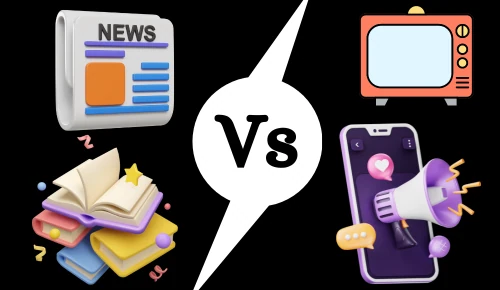In today’s world, media is an essential part of our daily lives. It helps us connect with the world, stay informed, and be entertained.
There are two main types of media: print media and electronic media. Understanding the differences between them can help us choose the best way to deliver our message to the audience.
Print media refers to traditional paper-based media, including books, newspapers, magazines, brochures, and flyers. It has been around for centuries, and it’s still popular in many parts of the world.
Print media has a unique set of characteristics that make it stand out. First, it’s tangible and physical, meaning that people can touch and feel it. This makes it durable and long-lasting. Second, it’s static, which means that the content doesn’t change once it’s printed. Third, it offers in-depth and detailed information on various topics.
But print media also has some disadvantages. Its reach is limited to those who have access to it, and it’s not as interactive as electronic media. It also has a limited shelf life, and the cost of production can be high.
On the other hand, electronic media includes any form of media delivered via electronic devices, such as televisions, radios, smartphones, and computers. It’s more dynamic and versatile, allowing for a greater level of interaction and engagement. It’s also easy to distribute and has a global reach.
However, electronic media also has its downsides. It’s over-saturated, which means that people are constantly bombarded with information, leading to a short attention span. Technical difficulties such as poor Wi-Fi or battery life can also impact user experience.
When comparing print and electronic media, several factors come into play. In terms of content creation, print media requires more time and effort, while electronic media is more immediate and can be produced quickly.
Audience reach is also a significant factor, as electronic media can reach a global audience with ease. Cost is another factor, as electronic media tends to be less expensive to produce compared to print media. Speed of delivery is also an important factor, as electronic media can upload news or information instantaneously while print media may have a delay in delivery.
Lastly, interaction and engagement are vital elements. Electronic media allows for immediate and interactive feedback to the media consumer while print media remains static.
In conclusion, both print and electronic media have their own set of advantages and disadvantages. Print media is traditional and tangible, while electronic media is versatile and delivers a global reach quickly. Future trends suggest that electronic media will continue to be dominant, but print media will still hold a place in our society. At the end of the day, choosing the right media format for your audience comes down to knowing who they are and what they want. Understanding the differences between print and electronic media will help you make an informed choice.
Difference between Print Media and Electronic Media
| Features | Print Media | Electronic Media |
| Format | Physical (newspapers, magazines, books) | Digital (websites, apps, TV, radio) |
| Content | Text, images (static) | Text, images, videos, audio (dynamic) |
| Access | Delivered to homes, bought at stores | Accessed through devices, often with internet |
| Updates | Limited (fixed content after printing) | Constant (can be updated anytime) |
| Reach | Local or regional | Global (accessible worldwide) |
| Interactivity | Limited (no direct response) | Interactive (can comment, share, vote) |
| Cost | Can be expensive (depending on publication) | Varies (free access to some, paid subscriptions for others) |
| Benefits | Tangible, portable, no screen time | Convenient, diverse content, real-time updates |
| Drawbacks | Limited reach, outdated information, environmental impact | Requires device and Internet access, potential for distractions |
